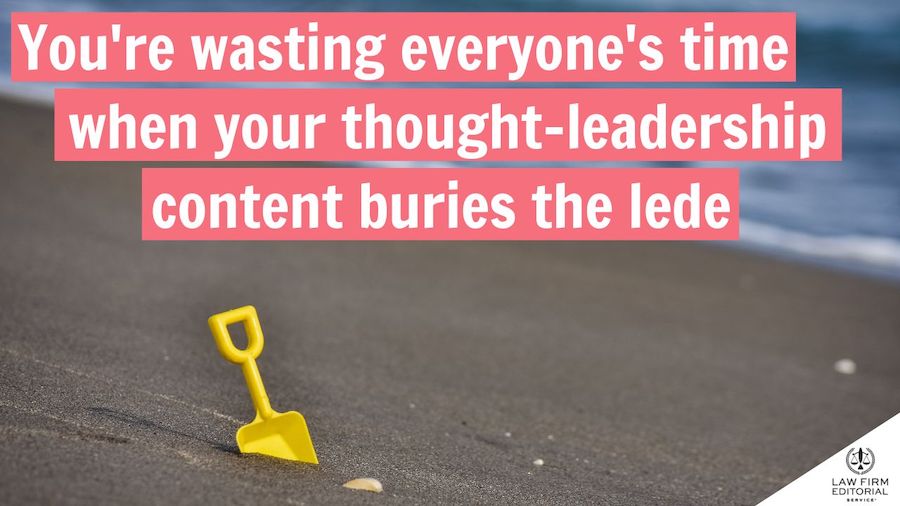If you want to build an audience for your thought leadership content, get to the point quickly in that content-or risk losing your credibility.
Don’t bury the lede when you write thought-leadership marketing content. In other words, make it clear early on in that content what the takeaway is.
As I am writing this blog post, most of the world is still battling the COVID-19 crisis - both on the health side of the ledger and on the business/economic side of the ledger.
Interestingly, the crisis has provided an unprecedented opportunity for attorneys and law firms to dive headfirst into creating thought-leadership content.
That’s because the crisis itself, as well as government actions designed to “flatten the curve,” have raised issues that touch most legal practices. Thus, for attorneys who understand how important thought leadership is to their overall marketing and business development efforts, the COVID-19 crisis has provided a near limitless amount of topics to address.
Same sin, different content
But with more opportunities for attorneys to engage in thought leadership comes more opportunities for those attorneys to commit the same sin they frequently committed in their pre-COVID-19 thought leadership: burying the lede.
Attorneys tend to create thought-leadership content in a way that makes it difficult for consumers of that content to quickly and easily understand what point the content is trying to make and what they should take away from it.
(The term “lede” comes from journalism. A lede paragraph is the first and most important paragraph of a news article because it provides the core “who,” “what,” “where,” “when,” and “why.” The lede paragraph gives the reader a general overview of the news event that caused the article to be written in the first place.)
Many attorneys struggle with getting to the point of what they’re saying-whether in court papers or in marketing content. How many introductions to a piece of attorney-written content have YOU seen where there is a long wind-up before the pitch actually comes? How often when this is the case have you lost interest in the piece because the author hasn’t given you an understanding of what you’ll gain from reading/watching/listening further?
(Now you know how some of your readers may feel if you bury the lede in your work product.)
Burying the lede is a massive time waster
When attorneys bury the lede and drive away consumers of their thought leadership, they’re wasting everyone’s time.
They’re wasting their own time because they are spending non-billable time creating content that’s unlikely to make the kind of positive impression on a reader that will compel them to take action by reaching out to the attorney to inquire about their services.
They’re also wasting readers’ time by attracting them to a piece of content that’s not useful to them, and then forcing them to keep searching for other content that is.
You can create compelling introductions without burying the lede
When you are creating thought-leadership content of any form, make it clear early on what the takeaway is. What is the point of this piece of content? Why should the consumer care about the recent court decision or legislative action you’re analyzing?
Make it clear why you’re talking about it, what’s so important, and what the consumer should do after they’ve consumed your content.
I’m not suggesting that getting to the point quickly means that you cannot or should not write a compelling introduction.
Compelling introductions help set the stage for readers and get them ready to examine the issue you’re discussing from your same perspective. But your introduction should not ramble on, leaving the consumer of the content to wonder “Why should I care?”
There is no downside to saying upfront what the takeaway is
You may be concerned that explaining the takeaway early on in your thought-leadership content will cause your content’s consumers to jump ship after they learn what it is.
Don’t be.
Explaining a takeaway upfront will boost your credibility with the people consuming your content because they will quickly see how easily you are able to crystallize complex issues and ideas. So even if they abandon your content after learning the takeaway, they’re leaving with a favorable impression of you-which is exactly the point of creating thought-leadership marketing content in the first place.
Also, many of your consumers are going to want to understand how and why you arrived at your takeaway, especially when you are exploring complex issues or providing counterintuitive guidance. They’re going to keep on reading/watching/listening. But they’ll greatly appreciate knowing where you’re heading before you take them there.
A valuable skill for all of your communications
The next time you create thought-leadership marketing content for your current and perspective clients and referral sources, don’t bury the lede.
Make it clear from the get-go what the point is and the reason why the consumers of your content should care.
Getting to the point quickly is a skill that is immensely helpful in your thought-leadership marketing. It will also be an asset to you in your general business communications.
Perhaps most importantly of all, it will undoubtedly serve you well in your communications outside of the office, particularly with your loved ones.
Do you have any idea how much revenue your law firm is missing out on by its attorneys writing their own thought-leadership marketing content? Visit writelessbillmore.com for a free thought-leadership cost calculator.

